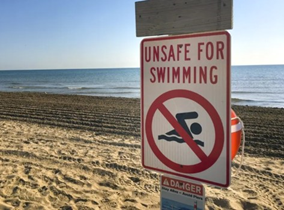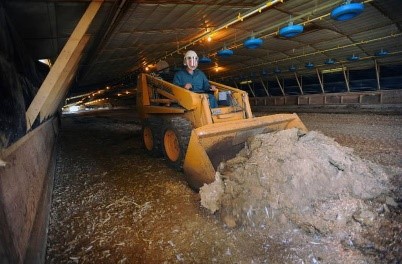The Chesapeake Bay deteriorates into a quagmire full of broken promises
After 40 years and $10 billion spent to restore the Chesapeake Bay’s polluted waters to meet basic Clean Water Act requirements, the U.S. Environmental Protection Agency and bay states have failed to do so.

Bay water contact can cause flesh eating diseases threatening life and limb from bacteria fueled by excessive nutrients flowing primarily from farms and urban stormwater runoff (Scott Anderson/Patch)
EPA data document that 71.9% of Chesapeake’s tidal waters remain impaired (polluted) — an improvement of just 1.6% since 1985 when 73.5% of bay waters were impaired.
Despite repeated agreements and mandatory reductions ordered by a court, the EPA has refused to impose meaningful penalties to force states to fulfill their commitments to reduce bay-choking nutrients and sediment. Instead, EPA leaders have punted, wrongfully alleging they are partners not enforcers of the Clean Water Act. Who then shall enforce the law?
Bay states, including Maryland, Virginia and Pennsylvania, have gladly joined the EPA in postponing the 2025 deadline to take necessary actions to clean up the degraded Chesapeake.
This occurs despite the states being allowed 15 years from 2010 to achieve mandated pollution reductions. A court settlement forced the EPA to impose these reductions after voluntary agreements repeatedly failed to do so. The EPA refused to impose any sanctions on bay states to ensure the attainment of commitments despite two subsequent lawsuits.
Nearly all states failed to meet 60% of their nutrient reductions by 2017. Now, EPA and the states acknowledge the 2025 deadline will not be met to attain 100% of the reductions. Once again, the EPA failed to impose sanctions to prod compliance.
Instead, the EPA and bay states gladly agreed to a “recalibration” of bay restoration plans in 2022. Instead of the states adopting new initiatives to curb agricultural and developed land pollutants, the major reason for the failure, EPA and the states decided to take until the end of 2025 to adopt a new plan.
An EPA Inspector General’s report of July 18, 2023, castigated EPA’s failure to embrace its leadership role to steer states toward addressing the most significant sources of remaining pollution. The IG report noted that the EPA knew how off-track bay restoration was in 2018 and still failed to act.
A Beyond 2025 Steering Committee was formed last summer to look at the 2014 Bay Agreement goals to achieve the necessary pollution reductions. The draft report came out on July 1 and it’s a giant nothing burger.
There are no specific actions to meet mandated pollutant reductions, to curb farm and development nutrients or to strengthen terms of the clean-up plans. The only reference to agriculture is an inaccurate claim of significant nitrogen reductions.
The EPA Bay Program recently concluded that such nitrogen reductions from all sources have been grossly overstated by nearly 50%. This is partly linked to increased farm fertilizer use, more farm animals and their excrement, and the ineffectiveness of farm best management practices despite $2 billion in grants to farmers since 2010.
The report fails to note the failure to achieve the most important overall goal of the 2014 Bay Agreement: Having all practices and controls installed to restore the bay’s water quality by 2025.

A record 596 million chickens were grown on the Eastern Shore producing 1.4 billion pounds of chicken poop, equivalent to the weight of 93,000 huge African bull elephants. Most was dumped on land polluting the Bay. (Baltimore Sun Media File Photo)
Record amounts of chicken manure from 600 million chickens grown on the Eastern Shore are disposed of on land, jolting creeks with Bay choking excess nutrients. (Edwin Remsberg/VWPics/Newscom)
In classic greenwashing typical of EPA and others regarding the Bay Program, the draft delivers a self-congratulatory message of how the Bay Program and the 2014 Agreement “continue to deliver valuable progress, locally, throughout the watershed and for the Chesapeake Bay itself.”
In a May 2023 report, 50 top bay scientists on the Bay Program’s scientific advisory committee reported the best that can be said is at least the bay has not gotten worse over the last 40 years.
They also found that Bay Program claims that phosphorus reductions were nearly achieved is contradicted by river monitoring stations finding limited evidence of reductions in phosphorus concentrations. The scientists also disputed significant gains in nitrogen reductions particularly from agriculture and other nonpoint sources.
The Beyond 2025 draft plan ignores these scientific conclusions and dismisses the need for a new Bay Agreement to meet the many challenges facing bay restoration, nor does it provide any details for what specific measures must be taken to achieve restoration.
This is a recognition that the EPA and states lack the commitment to implement necessary measures to curb agricultural and developed land pollutants. The plan is replete with suggested structural changes in the Bay Program that have little to do with reducing pollutants.
The chief recommendation is that EPA and bay states affirm their commitment to meet the goals of the 2014 Chesapeake Bay Agreement and adopt amendments to achieve the goals. However, the plan opens the door to reducing or replacing commitments not met. This tactic has been repeatedly employed in the past when critical goals are not met.
No mention is made of what needs to be done to achieve the 2014 Bay Agreement’s 13 of 31 commitments that are either not on course or completed. The Beyond 2025 report fails to note that the most critical goals are far from achievement. Instead, it sadly weaves successes out of abject failures. Set forth below are examples of this greenwashing.
Success is declared in the planting of 640 miles of forest buffers in 2023. But the commitment was to achieve 900 miles of forested buffers each year and to conserve existing buffers. The 900-mile goal was met only once, in 2002. Often only 10% of the 900 miles agreed upon were achieved.
The report touts how critical bay grasses (SAV) “are expected to show a strong rebound in 2024” — the Bay Program website does not confirm this. It does confirm that the goal set back in 2000 was to achieve 185,000 acres of SAV by 2010. In 2022, just 76,462 acres of underwater grasses were found, 41% of the Bay Program’s 185,000-acre goal.
The 2025 report sugarcoats this failure blaming Hurricane Agnes (1972) for the failure.
Left out of the 2025 plan’s braggadocio is that the 2014 Agreement committed to create or re-establish 85,000 acres of wetlands and enhance the function of an additional 150,000 acres of degraded wetlands by 2025. Between 2014 and 2022, just 4,310 new wetland acres were established and 60,666 wetland acres were enhanced.
The 2014 Agreement committed to increasing the urban tree canopy by 2,400 acres; instead, there was a 12,000-acre loss in the urban tree canopy.
The Beyond 2025 plan is devoid of any specifics to meet these commitments and attain compliance with the Clean Water Act. And undermining all new plans is the failure to include legally enforceable terms for meeting nutrient and sediment reductions with dates certain and enabling a court to order implementation upon failure to meet the required actions.
Without these enforceable measures, any new plan will end up like the other Bay Agreements.

Dead fish on the shore of Stoney Creek off the Magothy River killed by oxygen deprivation from an algal bloom linked to the failure to rein in nutrients. (Steve Droter)
One consequence of failure to improve Bay water quality is dead zones depriving fish of oxygen leading to kills like this on the South River. The giant bay dead zone is projected to be 4% larger this year than average. (Colleen Dugan/Courtesy Photo)
Future generations deserve better than a government that allows the can to be continually kicked down the road while the Chesapeake Bay’s degraded waters are causing a proliferation of flesh-eating diseases, as well as the collapse of fisheries and the failure to restore bay grasses.
You can comment on the Beyond 2025 draft plan by Aug. 30 at: https://www.chesapeakebay.net/news/blog/help-the-chesapeake-bay-program-chart-the-next-phase-of-bay-restoration. The 16-page draft can be accessed at this site.
Gerald Winegrad represented the greater Annapolis area as a Democrat in the Maryland House of Delegates and Senate for 16 years. Contact him at gwwabc@comcast.net.